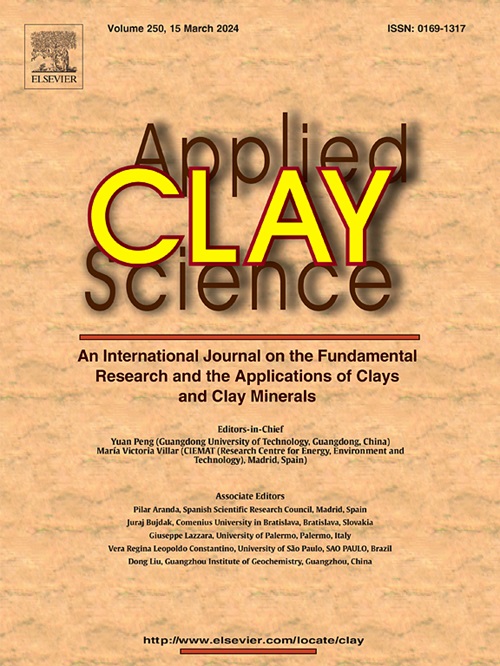Dehydroxylation kinetics of kaolinite and montmorillonite examined using isoconversional methods
IF 5.3
2区 地球科学
Q2 CHEMISTRY, PHYSICAL
引用次数: 0
Abstract
The use of calcined clays as supplementary cementitious materials (SCMs) in concrete is a promising strategy towards decarbonizing the cement and concrete industry. This is especially relevant considering the ever-increasing demand for concrete. Comprehensive understanding of the kinetics of calcination is essential towards maximizing the potential reactivity of clay minerals while ensuring energy efficiency. In this study, the kinetics of the dehydroxylation of kaolinite and montmorillonite are investigated under non-isothermal conditions at constant heating rate. Activation energies () are determined via Friedman differential and advanced Vyazovkin incremental methods over the isoconversional range; these are devoid of computational approximations, thus allowing kinetic analysis without assuming a specific reaction model. Kinetic equations—in the differential form as well as a combination of differential and integral forms are compared against the experimentally determined reaction models to identify the most probable dehydroxylation mechanism for kaolinite and montmorillonite. A reaction order mechanism is established for dehydroxylation of kaolinite, while montmorillonite is noted to undergo dehydroxylation via a single-step reversible diffusion-controlled process. Kinetic triplet—comprising activation energy, reaction model and pre-exponential factor—is used to predict isothermal calcination conditions, which is further verified using analytical techniques. Heat release rates of clay-portlandite blends from isothermal calorimetry are used within a thermodynamic framework to quantify reactivity of the calcined clays. The study demonstrates a general approach based on isoconversional methods to predict calcination conditions for different clays that can be used in efficient and optimized production of blended cements or SCMs.
用等转化方法研究了高岭石和蒙脱土的脱羟基动力学
在混凝土中使用煅烧粘土作为补充胶凝材料(SCMs)是一种很有前途的水泥和混凝土工业脱碳策略。考虑到对混凝土的需求不断增加,这一点尤为重要。全面了解煅烧动力学对于最大限度地提高粘土矿物的潜在反应活性,同时确保能源效率至关重要。本文研究了高岭石和蒙脱土在非等温条件下,恒升温速率下的脱羟基反应动力学。在等转换范围内,通过Friedman微分和先进的Vyazovkin增量法确定活化能(Ea);这些都是缺乏计算近似,因此允许动力学分析,而不假设一个特定的反应模型。将微分形式的动力学方程以及微分形式和积分形式的组合与实验确定的反应模型进行比较,以确定高岭石和蒙脱石最可能的脱羟基化机制。建立了高岭石脱羟基的反应顺序机制,而蒙脱土的脱羟基是通过单步可逆扩散控制过程进行的。由活化能、反应模型和指数前因子组成的动力学三重体用于预测等温煅烧条件,并通过分析技术进一步验证。从等温量热法中得到的粘土-硅酸盐混合物的放热率在热力学框架内用于量化煅烧粘土的反应性。该研究展示了一种基于等转换方法的通用方法,用于预测不同粘土的煅烧条件,可用于高效和优化混合水泥或SCMs的生产。
本文章由计算机程序翻译,如有差异,请以英文原文为准。
求助全文
约1分钟内获得全文
求助全文
来源期刊

Applied Clay Science
地学-矿物学
CiteScore
10.30
自引率
10.70%
发文量
289
审稿时长
39 days
期刊介绍:
Applied Clay Science aims to be an international journal attracting high quality scientific papers on clays and clay minerals, including research papers, reviews, and technical notes. The journal covers typical subjects of Fundamental and Applied Clay Science such as:
• Synthesis and purification
• Structural, crystallographic and mineralogical properties of clays and clay minerals
• Thermal properties of clays and clay minerals
• Physico-chemical properties including i) surface and interface properties; ii) thermodynamic properties; iii) mechanical properties
• Interaction with water, with polar and apolar molecules
• Colloidal properties and rheology
• Adsorption, Intercalation, Ionic exchange
• Genesis and deposits of clay minerals
• Geology and geochemistry of clays
• Modification of clays and clay minerals properties by thermal and physical treatments
• Modification by chemical treatments with organic and inorganic molecules(organoclays, pillared clays)
• Modification by biological microorganisms. etc...
 求助内容:
求助内容: 应助结果提醒方式:
应助结果提醒方式:


